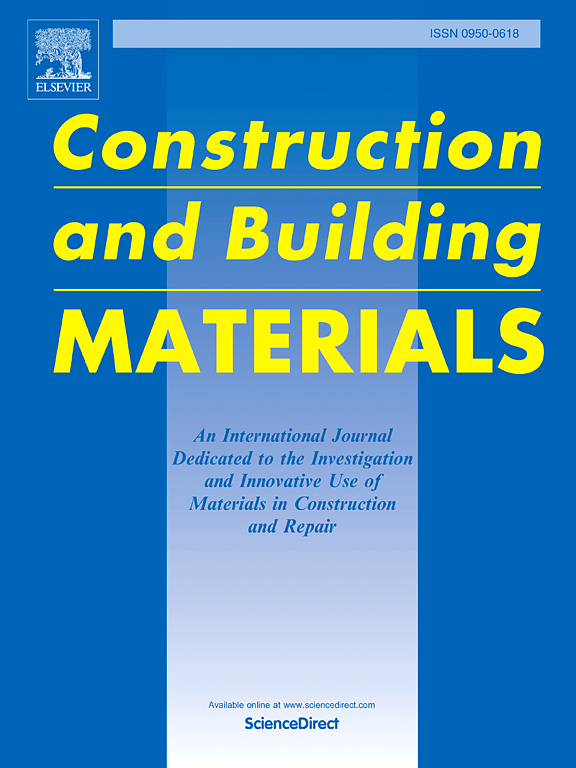Recycling copper slag as precursor in alkali-activated materials: Reaction mechanisms, microstructural features, and environment impact
IF 8
1区 工程技术
Q1 CONSTRUCTION & BUILDING TECHNOLOGY
引用次数: 0
Abstract
This study explores the feasibility of incorporating copper slag (CS) as a partial mineral precursor in alkali-activated materials (AAM). By utilizing ground granulated blast furnace slag (GGBS), fly ash (FA), and CS as precursors, a novel three component eco-friendly binder has been successfully developed. The study comprehensively assesses the influence of CS on the reaction rate, microstructural feature, and environment impact of AAM system. Compared to FA, CS exhibits higher solubility of silica and calcium, which can participate more effectively in geopolymerization and play a notable role in the formation of C-(A)-S-H gels. A K-D model was constructed using heat release data, revealing that the addition of CS significantly enhances the reaction extent. This led to a 33.3 % increase in the compressive strength of the matrix at 3 d and a notable enhancement in the degree of polymerization of the gel network. Microstructural analysis demonstrates that increasing CS substitution improves gel enrichment and pore filling effects. This optimization of the pore structure resulted in a decrease in both porosity and the quantity of large sized pores. From an economic and environmental perspective, reusing CS brings about a substantial decline in both energy consumption and carbon emissions, achieving a 56.92 % decrease in energy consumption and a 75.81 % reduction in carbon emissions. Such work may shed valuable insights to the recycling of various types of solid waste and low-carbonation of building field.
回收铜渣作为碱活化材料的前驱体:反应机理、微观结构特征和环境影响
本研究探讨了在碱活化材料(AAM)中加入铜渣作为部分矿物前驱体的可行性。以矿渣(GGBS)、粉煤灰(FA)和粉煤灰(CS)为前驱体,成功研制了一种新型的三组分环保型粘结剂。本研究综合评价了CS对AAM体系的反应速率、微观结构特征和环境影响的影响。与FA相比,CS具有更高的二氧化硅和钙的溶解度,可以更有效地参与地聚合,对C-(a)- s - h凝胶的形成起着显著的作用。利用放热数据建立K-D模型,发现CS的加入显著提高了反应程度。这导致基质在3d时抗压强度增加33.3% %,凝胶网络的聚合程度显著增强。微观结构分析表明,增加CS取代可以改善凝胶富集和孔隙填充效果。这种孔隙结构的优化导致孔隙率和大孔数量的减少。从经济和环境的角度来看,CS的再利用带来了能源消耗和碳排放的大幅下降,能源消耗下降56.92 %,碳排放减少75.81 %。这些工作对各类固体废物的回收利用和建筑领域的低碳化具有重要的指导意义。
本文章由计算机程序翻译,如有差异,请以英文原文为准。
求助全文
约1分钟内获得全文
求助全文
来源期刊

Construction and Building Materials
工程技术-材料科学:综合
CiteScore
13.80
自引率
21.60%
发文量
3632
审稿时长
82 days
期刊介绍:
Construction and Building Materials offers an international platform for sharing innovative and original research and development in the realm of construction and building materials, along with their practical applications in new projects and repair practices. The journal publishes a diverse array of pioneering research and application papers, detailing laboratory investigations and, to a limited extent, numerical analyses or reports on full-scale projects. Multi-part papers are discouraged.
Additionally, Construction and Building Materials features comprehensive case studies and insightful review articles that contribute to new insights in the field. Our focus is on papers related to construction materials, excluding those on structural engineering, geotechnics, and unbound highway layers. Covered materials and technologies encompass cement, concrete reinforcement, bricks and mortars, additives, corrosion technology, ceramics, timber, steel, polymers, glass fibers, recycled materials, bamboo, rammed earth, non-conventional building materials, bituminous materials, and applications in railway materials.
 求助内容:
求助内容: 应助结果提醒方式:
应助结果提醒方式:


